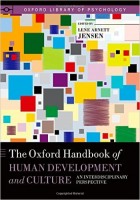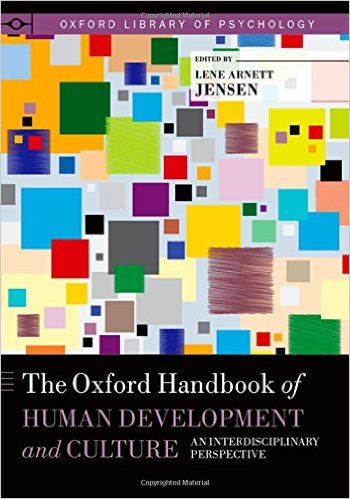 Editor: Lene Arnett Jensen
Editor: Lene Arnett Jensen
Publisher: Oxford University Press – 742 pages
Book Review by: Sonu Chandiram
In this book, Lene Arnett Jensen uses what she describes as a “cultural-development approach” to studying human development. She provides “a comprehensive synopsis of theory and research” in this specialty within psychology by looking at unique findings about different cultures around the world. This type of perspective includes:
- Cultural diversity within nations
- Cultural change
- Globalization
This unique project was made possible with contributions from 99 specialists in various fields (aging, child study, education, human development, medicine, psychiatry, psychology, and sociology, to name some) from the United States and nine other countries – Brazil, Cameroon, Canada, India, Japan, the Netherlands, Romania, Sweden, and Turkey.
They provided content to the 43 chapters of this book. It is organized into six Parts, and after the first one, which is an introduction to living in a new sort of global culture, the other five describe the chronological stages in human life span:
- Part One – Development and Culture in a Global World: Overarching Issues
- Part Two – Birth, Infancy, and Toddlerhood
- Part Three – Early and Middle Childhood
- Part Four – Adolescence
- Part Five – Emerging and Young Adulthood
- Part Six – Middle and Older Adulthood
Among other matters, this volume discusses:
- Development of cognition, creativity, emotion, language, morality and religion
- Developmental contexts: civic institutions, family, friends, media, school, and work
- Interdisciplinary approach to scholarship that bridges universal and cultural perspectives on human development
- Cultural-development approach: a dynamic, flexible, multifaceted way to conceptualize theory and research; a new and more relevant way to look at human development in today’s world
This book is for those who are interested in the study of human development, particularly its psychological aspects. But it’s different from others on this subject in that it provides information on how people of different cultures develop and mature, going through all periods of human development from birth to old age.
Most chapters have these sections as part of their organizational format:
- Chapter Title
- Authors’ Bylines
- Abstract
- Key Words
- Discussions of topics and subtopics
- Conclusion
- References
Some of the chapters do not have a Conclusion. The lists of References are usually quite extensive, and useful in delving deeper into some subjects, or reading others’ findings and viewpoints on the topics covered in this book.
This caught my interest in the book: chapter 41, Adult Development in Japan and the United States: Comparing Theories and Findings about Growth, Maturity, and Well-Being. Written by 13 authors from the West as well as the East, it compares and contrasts values and other important matters taught in the United States and in Japan.
Here’s a portion of what is written in the Abstract: “This chapter examines early formulations of adult development in the U.S. and contrasts them with notably different conceptions of aging in Japan. Empirical research in both cultures points to evidence of psychological change in personality traits, well-being, and affect with aging in the U.S., whereas Japanese studies have linked the well-being of older persons to life roles and activities as well as examined the concept of ikigai (what makes life worthy).”
An interesting first-person narrative is written by Mayumi Karasawa, one of the co-authors of this chapter. She relates of an instance when she went with a friend to a cozy restaurant in the Upper East Side of New York during her first visit to that city as a student. A well-dressed Japanese old lady wearing a fine suit, with well-cared-for hair, matching nails and lipstick, was seated by herself in a corner of that restaurant.
She told her friend that she felt sorry for that woman eating dinner all by herself, not having family with whom to have company and share her meal. And her friend responded, almost sounding upset: “You are unfair. I think she has a nice life; she is rich and can dress well and go to nice restaurants. She is healthy enough to come by herself. Do not tell me that she is lonely and sad.”
Mayumi learned from this incident that each culture has different sets of values and priorities, and these are learned by younger members in different settings through a variety of ways. What is perceived in the U.S. and by Americans elsewhere as being lonely is not at all seen that way by the Japanese.
The authors write that the purpose of this chapter is “to review formulations of adult development in two different cultural contexts, with a focus on how personal growth in the second half of life is theoretically conceptualized and empirically investigated.” They then go on to state that in the chapter they will review theories of adult development over the last 50 years in the U.S. and Europe.
This book is unique, unusual, and different from others in its field of study. With it Dr. Jensen, using an interdisciplinary approach, and the contributions of numerous authoritative specialists, takes a bold, pioneering look at human development from varied cultural perspectives, using solid research to validate the conclusions.
Lene Arnett Jensen, PhD is associate professor of psychology at Clark University, Worcester, Massachusetts. She is the originator of the cultural development approach for scholarship on human development.
Her research addresses moral, civic, and cultural identity development in the context of globalization. A native of Denmark, Dr. Jensen has resided in a number of countries, including Belgium, France, and India. She lives in Massachusetts with her husband and twin children.







